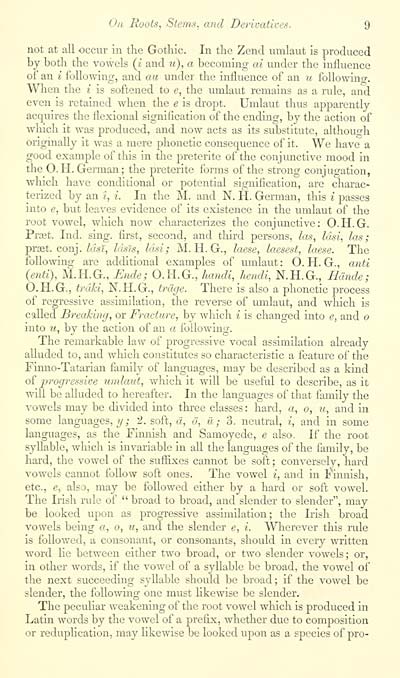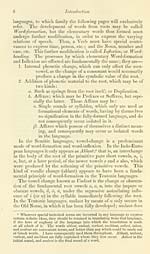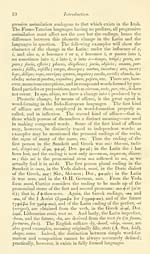Blair Collection > Celtic studies
(39)
Download files
Complete book:
Individual page:
Thumbnail gallery: Grid view | List view

On Roots, Stems, and Derlvatlces. 9
not at all occur in the Gotliic. In the Zend umlaut is produced
by both the vowels (i and u), a becoming ai under the influence
of an i following, and au under the influence of an u following,
WHien the i is softened to e, the umlaut remains as a rule, and
even is retained when the e is dropt. Umlaut thus apparently
acquires the flexional signification of the ending, by the action of
which it was produced, and now acts as its substitute, although
originally it was a mere phonetic consequence of it. We have a
good example of this in the preterite of the conjunctive mood in
the O.H.German; the preterite forms of the strong conjugation,
wliich have conditional or potential signification, are charac-
terized by an t, i. In the M. and N. H. German, this i passes
into e, but leaves evidence of its existence in the umlaut of the
root vowel, which noAV characterizes the conjunctive: O.II.G.
Pra3t. Ind. sing, first, second, and tliird persons, las, Idsi, las;
prcet. conj. /«s2', IdsTs, Idsi; M. H. G., laese, laesest, laese. The
following are additional examples of umlaut: O. H. G., anti
(enti), M.H.G., Ende; O.H.G., haudi, hendi, N.H.G., Bande ;
O.H.G., trdki, N.H.G., ti'dge. There is also a phonetic process
of regressive assimilation, the reverse of umlaut, and which is
called Breaking, or Fracture, by which i is changed into e, and o
into u, by the action of an a following.
The remarkable law of progressive vocal assimilation already
alluded to, and which constitutes so characteristic a feature of the
Finno-Tatarian family of languages, may be described as a kind
of progressive umlaut, which it will be useful to describe, as it
will be alluded to hereafter. In the languages of that family the
vowels may be divided into three classes : hard, a, o, u, and in
some languages, _y; 2. soft, a, o, it; 3. neutral, i, and in some
languages, as the Finnish and Samoyede, e also. If the root
syllable, which is invariable in all the languages of the family, be
hard, the vowel of the sufiixes cannot be soft; conversely, hard
vowels cannot follow soft ones. The vowel i, and in Finnish,
etc., e, also, may be followed either by a hard or soft vowel.
The Irish rule of " broad to broad, and slender to slender", may
be looked upon as progressive assimilation; the Irish broad
vowels being a, o, u, and the slender e, i. Wlierever this rule
is followed, a consonant, or consonants, should in every written
word lie between either two broad, or two slender vowels; or,
in other words, if the vowel of a syllable be broad, the vowel of
the next succeeding syllable should be broad ; if the vowel be
slender, the follomng one must likewise be slender.
The peculiar weakening of the root vowel which is produced in
Latin words by the vowel of a prefix, whether due to composition
or reduplication, may likewise be looked upon as a species of pro-
not at all occur in the Gotliic. In the Zend umlaut is produced
by both the vowels (i and u), a becoming ai under the influence
of an i following, and au under the influence of an u following,
WHien the i is softened to e, the umlaut remains as a rule, and
even is retained when the e is dropt. Umlaut thus apparently
acquires the flexional signification of the ending, by the action of
which it was produced, and now acts as its substitute, although
originally it was a mere phonetic consequence of it. We have a
good example of this in the preterite of the conjunctive mood in
the O.H.German; the preterite forms of the strong conjugation,
wliich have conditional or potential signification, are charac-
terized by an t, i. In the M. and N. H. German, this i passes
into e, but leaves evidence of its existence in the umlaut of the
root vowel, which noAV characterizes the conjunctive: O.II.G.
Pra3t. Ind. sing, first, second, and tliird persons, las, Idsi, las;
prcet. conj. /«s2', IdsTs, Idsi; M. H. G., laese, laesest, laese. The
following are additional examples of umlaut: O. H. G., anti
(enti), M.H.G., Ende; O.H.G., haudi, hendi, N.H.G., Bande ;
O.H.G., trdki, N.H.G., ti'dge. There is also a phonetic process
of regressive assimilation, the reverse of umlaut, and which is
called Breaking, or Fracture, by which i is changed into e, and o
into u, by the action of an a following.
The remarkable law of progressive vocal assimilation already
alluded to, and which constitutes so characteristic a feature of the
Finno-Tatarian family of languages, may be described as a kind
of progressive umlaut, which it will be useful to describe, as it
will be alluded to hereafter. In the languages of that family the
vowels may be divided into three classes : hard, a, o, u, and in
some languages, _y; 2. soft, a, o, it; 3. neutral, i, and in some
languages, as the Finnish and Samoyede, e also. If the root
syllable, which is invariable in all the languages of the family, be
hard, the vowel of the sufiixes cannot be soft; conversely, hard
vowels cannot follow soft ones. The vowel i, and in Finnish,
etc., e, also, may be followed either by a hard or soft vowel.
The Irish rule of " broad to broad, and slender to slender", may
be looked upon as progressive assimilation; the Irish broad
vowels being a, o, u, and the slender e, i. Wlierever this rule
is followed, a consonant, or consonants, should in every written
word lie between either two broad, or two slender vowels; or,
in other words, if the vowel of a syllable be broad, the vowel of
the next succeeding syllable should be broad ; if the vowel be
slender, the follomng one must likewise be slender.
The peculiar weakening of the root vowel which is produced in
Latin words by the vowel of a prefix, whether due to composition
or reduplication, may likewise be looked upon as a species of pro-
Set display mode to: Large image | Transcription
Images and transcriptions on this page, including medium image downloads, may be used under the Creative Commons Attribution 4.0 International Licence unless otherwise stated. ![]()
| Early Gaelic Book Collections > Blair Collection > Celtic studies > (39) |
|---|
| Permanent URL | https://digital.nls.uk/75771611 |
|---|
| Description | A selection of books from a collection of more than 500 titles, mostly on religious and literary topics. Also includes some material dealing with other Celtic languages and societies. Collection created towards the end of the 19th century by Lady Evelyn Stewart Murray. |
|---|
| Description | Selected items from five 'Special and Named Printed Collections'. Includes books in Gaelic and other Celtic languages, works about the Gaels, their languages, literature, culture and history. |
|---|

